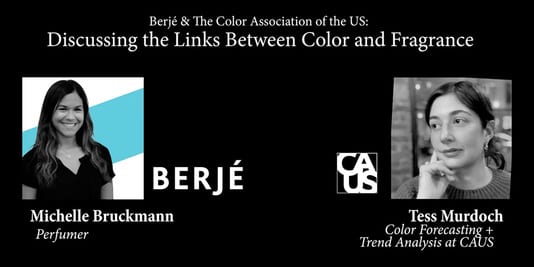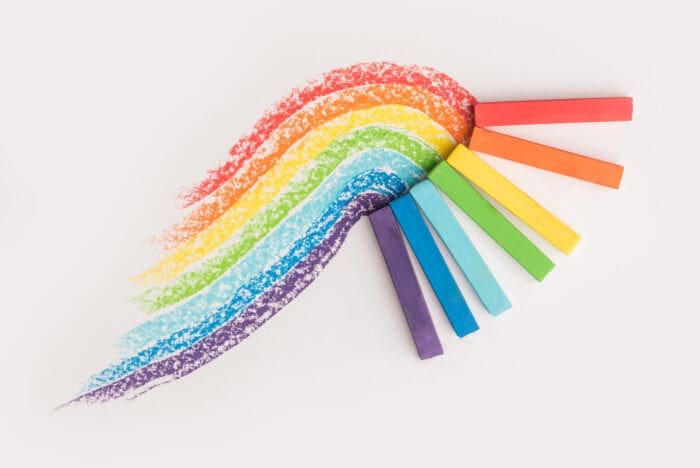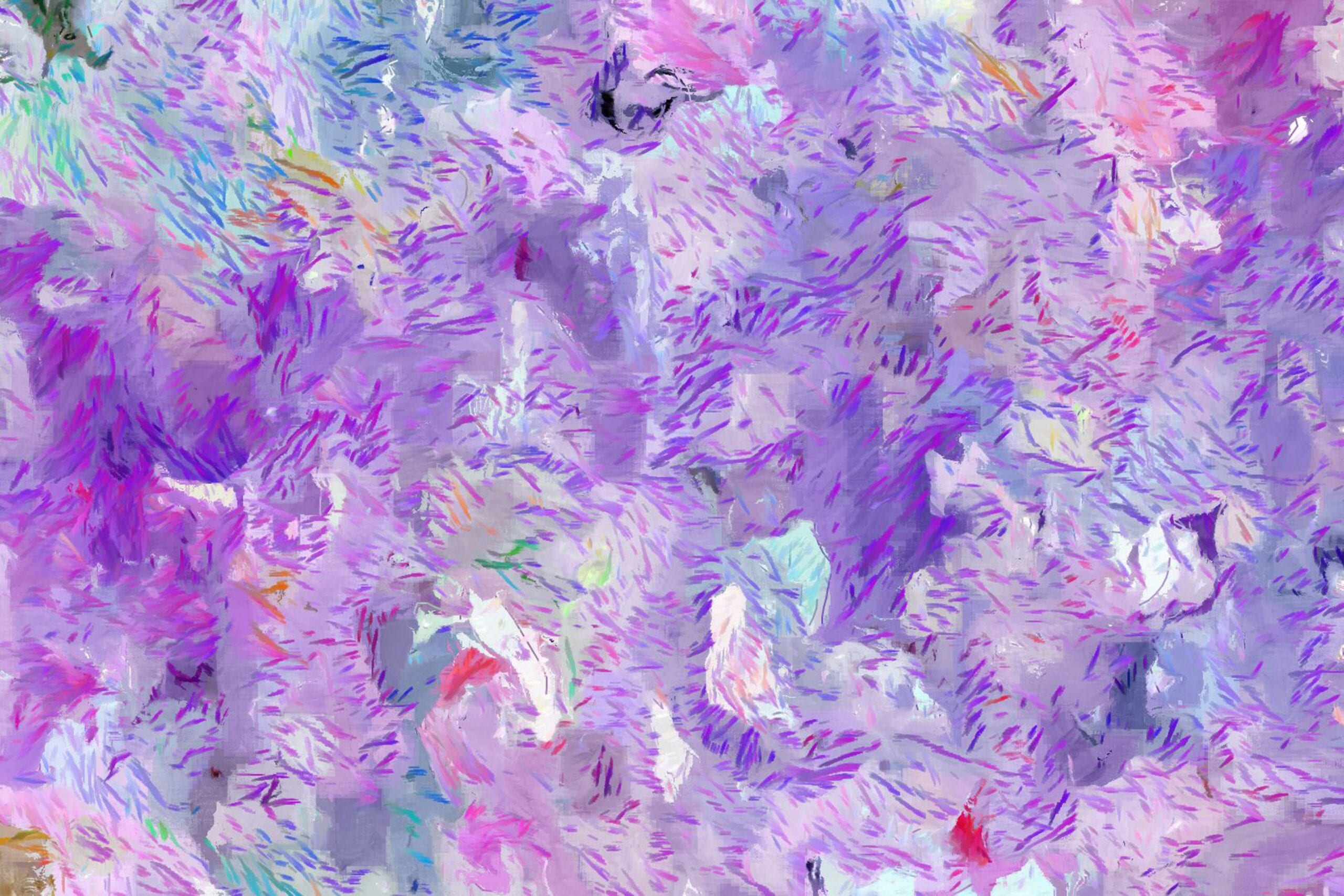
To view the full interview between Michelle and Tess, check out our Official YouTube Channel.
Michelle Bruckmann, a long-time perfumer at Berjé, recently sat down for an interview with Tess Murdoch of the Color Association of the United States. Together, the pair discuss how color influences the world of flavor and fragrance, touching upon the various scented “color” notes and how the aesthetics of color can influence the public’s perception of certain products. Michelle also discusses her early days as a lab worker within the fragrance industry, as well as how color influences many aspects of her everyday life.
For the abridged version of the interview, please see below.
Tess Murdoch (TM): How does one become a perfumer? There is so much chemistry involved within perfumery and I think this is an aspect that is often overlooked by people who are unfamiliar with the fragrance industry; can you elaborate on this?
Michelle Bruckmann (MB): My training was pretty unique. I’ve worked with many awesome perfumers and they were always willing to share their knowledge with me. One of my earliest roles in the chemical industry was as a perfumer’s technician. I did that for several years and learned most of what I know now through all the compounding I ended up doing. I continued to work and develop those compounding skills even while I was attending summer classes at college. Eventually, I moved up to managing the fragrance lab while still pursuing perfumery, starting an apprenticeship with a Senior Perfumer and Technical Perfumer a few years after that. I studied and memorized all sorts of essential oils and aromatic chemicals, getting lessons on how to make accords (which are a key group of materials within a composition that define the basic structure of a fragrance). I also learned about the more technical aspects of perfumery, such as reading GCs and analyzing the chemical structure of essential oils.
Becoming a perfumer takes passion, many years of training, and most importantly, creativity. There’s definitely a lot of chemistry involved with perfumery, as all essential oils and aroma-chemicals are made up of specific molecules. When you start combining these molecules, that’s when the “chemistry” really starts to sink in. Some have good reactions and some don’t! If you don’t know the chemistry behind why different ingredients smell a certain way when they are blended together, it’s pretty difficult to make a formula that will consistently work! Not to mention the additional factors that come into play, such as odor duration and maturation. But all that comes through a combination of experience and training.
TM: Was your sense of smell always this strong or was this sensitivity something you trained yourself in overtime? Did you have to develop the discipline for heightened scent awareness on your own or was it taught to you?
MB: I’ve always had a strong sense of smell. It actually drove my mom crazy because I would always complain about certain smells that she didn’t even notice. However, I did have to train myself to distinguish between different notes and materials. I was often asked to “nose dupe” a fragrance during my apprenticeship. This basically meant I had to smell a fragrance and then break it down into a formula just based on its odor.
“Fragrance and Color echo one another.”
Charles Baudelaire
TM: Can you recall your first ‘scent memory’? If so, was there a color association as well?
MB: My first scent memory, ironically, is crayons. I have one brother who is 3 ½ years older than me, so when he started going to school, it was just me and my mom home alone with one another. I loved being at home with her all day, doing stuff around the house and running errands. So when it finally came time for me to leave home and go to school myself, I was definitely not ready to stop spending time with my bestie! Needless to say, the first day of kindergarten was very stressful. I remember walking into the classroom and seeing the other kids crowded around tables with tubs of crayons. At that moment, all I could smell was the waxy odor of Crayola. I immediately started crying and said to my mom, “I do not want to hang out with these kids or teachers!” It was a tough transition for me. To this day, the waxy smell of colored crayons immediately transports me back to that kindergarten classroom.
TM: Color, sensorially, is something deeply interlinked with the human consciousness, as well as our daily lives. In this way, scent and color are very similar – how do you think these two worlds complement and/or challenge each other? You have mentioned that colors are often used to describe specific attributes of a scent; how do create the mental connection between color descriptors and odors, as well as incorporate those connections into your work?
MB: Scent and Color are absolutely interlinked. I actually came across a quote from a French poet to describe this: “Fragrance and color echo one another.” I love it because I think it’s so true. Color evokes both images and scents. Pink with fruity, brown as earthy, orange as citrus. Scents bring back all sorts of memories and visuals. Perfumers always create something designed to evoke a certain emotion and craft something that people can feel a real connection to. It’s a connection that’s so difficult to describe that we often borrow terms from other areas of experience like music, colors, and flavors. Everyone comes from different backgrounds and experiences, so everyone can interpret things differently. This can sometimes create conflict, as one person might interpret a color or fragrance in a completely different way when compared to someone else.
TM: Is creating a fragrance a ‘visual experience’ for you, as well as something that happens in the nose/brain? If so, in what way…? Is a mood-board helpful?
MB: Creating a fragrance is certainly a visual experience. I especially enjoy working on briefs that are very specific and provide mood boards. Every fragrance I create has the goal of transporting the person smelling it to the place or idea I had envisioned in my head. Packaging can also play a huge role in the fragrance’s inspiration. The full sensory experience of color, texture, and aroma all need to relate to one another for a successful product launch.
TM: We at The Color Association are in the business of color forecasting; is there such a thing as scent forecasting?
MB: Our marketing team does most of our fragrance trend forecasting. They gather information from what’s going on in the worlds of fashion, music, and social media to see where customer sentiment and trends are going. Marketing usually presents these findings to the creative team and we create our fragrances based on what they provide us with. This often comes in the form of mood boards, videos and color palettes. Many of these trends are circular and patterned; just like how colors come back into fashion, certain fragrance accords go in and out of style every few years. Rose is a perfect example of this; it seems like clockwork that every 20 years or so, roses “bloom” once again with the mainstream. This trend mirrors all the rose gold and light pastel pink packaging we saw in the market around 5 years ago. Today, rose is coming back with a much darker, deeper, candied, almost purple/black sort of association.

TM: What’s the worst (or most complex) thing you ever smelled and did color play a major role in that experience?
MB: We once had a project to provide fragrances for a haunted house. They were very specific on the different types they wanted. One of them was urine. Thankfully, I was not doing perfumery at the time, so I did not have to create it. However, I did have to smell it being made in the lab. It was by far the worst thing I have ever smelled in my life! I immediately associated it with an orange-yellow color, for obvious reasons…
TM: If you could have created a fragrance for a historical figure, who would it be?
MB: Historical figure…that’s a tough one. I think it would be fun to work with someone that is energetic and creative. Celia Cruz comes to mind.
TM: How long, roughly, does it take you to create a fragrance? Do timelines change depending on the product or client?
MB: We are almost always under specific timelines with our customers. I’d say it takes an average of 6 to 12 months for a fragrance to get its final approval. Some fragrances are “targeted,” with a specific goal in mind. Others are done in the style of more free-form, creative passion-projects. These passion-project fragrances may be in different stages of development for months at a time, as I continuously refine and revisit them. I have no real target in mind when working on these types of fragrances other than creating something I love, usually because I’ve been inspired by something or someone in my life.
TM: How many fragrances might you be working on at one time?
MB: On average, I work on 6 to 10 projects at a time.
TM: Does your nose ever ‘switch off’?
MB: My nose doesn’t necessarily “switch off.” However, it does get fatigued by the end of the day, depending on the type or amount of fragrances I’ve smelled.
TM: If you had to choose one color-associated fragrance note above all others as your absolute favorite, which one would you choose?
MB: I love “blue” notes. I interpret them as watery and often think of the ocean while working with them. I live by the beach and spend a lot of time there, so it evokes feelings of family and great memories.
TM: What can each of us do to enhance our sense of smell?
MB: If someone wants to enhance their own appreciation of fragrance, one should simply smell more. Smell the food you’re cooking and the aromas that come from it as you add each ingredient. Sniff the wine you drink before you sip it. Smell the different produce items you buy. Burn more candles for mood enhancement. Whenever you sniff something, close your eyes and think deeply about how it makes you feel. That’s the best way to start building a better appreciation for fragrance.
